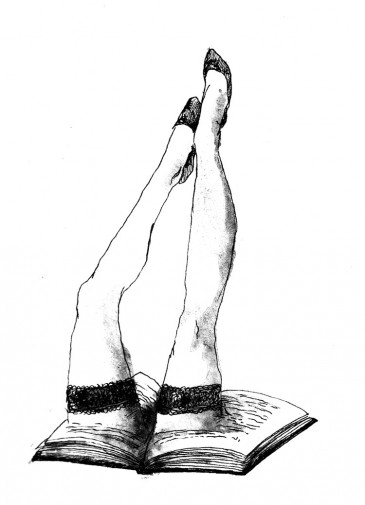Written by Becki L. Ross, a sociology professor at UBC, Burlesque West traces the trajectory of the burlesque moment from the 1950s to its reemergence on the cultural landscape today.
Unbelievably for an urban centre that has now earned the moniker No Fun City, in the 1950s Vancouver was regarded as the Las Vegas of Canada due to its vibrant burlesque scene. The ‘50s represented the glory days of erotic entertainment in Vancouver, marked by neon signage and a developed sense of community, with designers loaning costumes to dancers to secure employment. Offering live musical accompaniment and elaborate costumes, cabaret shows were viewed as an art form and were frequented by respectable couples for an evening’s entertainment. This trend continued throughout the ‘60s with the advent of topless dancing, ushered in by way of Chinatown, which at the time was a booming and vibrant entertainment district.

The industry changed drastically as full nudity was decriminalized in 1972 and bottomless shows came into prominence. Lunch shows began to operate in bars and this trend developed into the 1980s bar culture—which survives to this day—with beer parlours playing prerecorded music and featuring onstage showers and being pressured to do spread shows, where performers exposed themselves in the most graphic way possible. [ed. I asked Melissa what a spread show was and she said it was “showing the pink” which clarified it enough for me at least.] Prior to this time, women in their 40s could command a higher salary than newcomers to the scene, due to their experience and ability to put on a well crafted show. However, as the climate changed from artistry to licentiousness, women’s economic livelihood became less about talent and more about a willingness to completely expose themselves; veterans of the cabaret scene left the business.
Aside from tracing the downward spiral of disrobing as an art form, what makes this book a particularly interesting read is the definitive role that governmental regulations played and the effects their actions had on the once thriving cabaret scene. In order to obtain a cabaret license, a venue needed to provide a three-piece band and a vocalist. City councilors granted cabaret licenses fairly liberally, but liquor licenses, which were a necessary component in helping to pay the costs of operating a cabaret, were granted separately by the liquor control board and seemed to operate on an East/West divide.
The West End consisted of establishments primarily owned by white men and frequented by white, middle-class clientele, while the East Side businesses were leased to men of colour and catered to a racially diverse clientele. The dancers in the West End tended to be white ‘A’ list dancers while East Side cabarets presented both white dancers and women of colour and featured the first transsexual performers. West End premises were granted liquor licenses (the Penthouse being an exception, presumably due to the variety in its customer base) which helped offset their operating costs while East Side venues were repeatedly denied liquor licenses with little explanation. This situation resulted in East Side businesses turning a blind eye to BYOB practices and selling ice, mixers and sometimes even alcohol to keep their economic livelihoods afloat. East Side premises were repeatedly raided and fined (in the case of Harlem Nocturne, the only establishment in town with a black owner, raids sometimes occurred two or three times daily) for disobeying liquor laws that they had repeatedly sought permission to obey.
To compound this, the legalization of bottomless dancing saw bars beginning to offer fully nude shows. As bars and cabarets were granted different licenses, they had a definite advantage over traditional burlesque venues. While cabarets were bound to reduced operating hours and the need to supply live entertainment, bars were licensed to open much earlier, stay open twice as long, and could use prerecorded music. This development had devastating effects on cabarets, as their profit loss meant they could no longer afford to offer Vegas-style acts and were forced to close their doors, spelling unemployment for many of the city’s musicians who earned their livelihood at the cabarets, as well as those dancers who were more interested in putting on a real show rather than a spread show.
Although the author does not draw this comparison, it is impossible not to see a parallel between post-war cabaret culture and the climate surrounding Vancouver city council’s current position on live music venues. Just as the refusal to grant liquor licenses to cabarets based on a misguided stance of moral protectionism resulted in degradation to both culture and community, one only has to visit the government-sanctioned cultural wasteland known as the Granville “entertainment” district to see that history has repeated itself. And like the neo-burlesque revival that is gaining popularity in the city, supporters of alternative venues will organize, mobilize and form their own resurgence.

